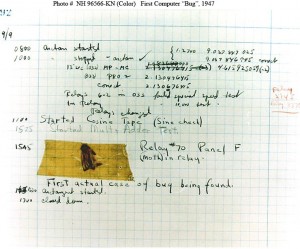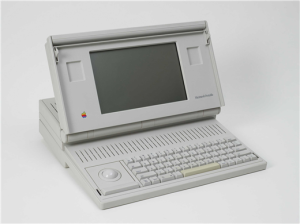Computers
Osborne Declares Bankruptcy
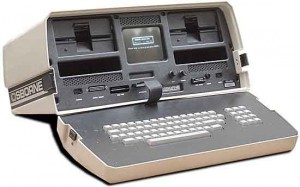
The Osborne Computer Corporation declares bankruptcy only two years after producing the first portable computer, the Osborne I. Computer industry lore has it that the “Osborne Effect” killed the company, but it was also due to competitive pressure and mismanagement.
The First Computer “Bug”
Operators of the Harvard Mark II find a moth trapped in relay #70 in panel F. The bug is taped to their troubleshooting log where it was written, “First actual case of bug being found”. This was not the first use of the term “bug” for computer problems, but this was the first time the term “debug” was used.
Last IBM “Stretch” Computer Shut Down
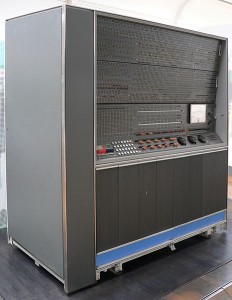
The last IBM 7030 “Stretch” mainframe in active use is decommissioned at Brigham Young University. The first Stretch was delivered to Los Alamos National Laboratory in 1961, giving the model almost 20 years of operational service. The Stretch was famous for many things, but perhaps most notably it was the first IBM computer to use transistors instead of vacuum tubes, it was the first computer to be designed with the help of an earlier computer, and it was the world’s fastest computer from 1961 to 1964.
Aldus – Adobe Merger Finalized
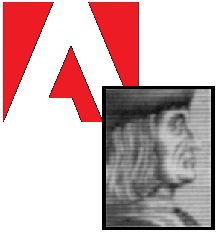
Aldus, the company that created PageMaker – considered the world’s first desktop publishing application – merges with Adobe, the company that created PostScript – which was the page description language powering many early laser printers. The combination of Pagemaker running on Apple’s Macintosh and printing to the Apple’s PostScript-powered LaserWriter sparked the desktop publishing revolution in the 1980’s.
The Birth of Linux

Linus Torvalds posts a message to the Internet newsgroup comp.os.minix with the subject line “What would you like to see most in minix?” This is the first announcement that he is working on an operating system that will one day become Linux.
HP Incorporated

Hewlett-Packard is incorporated by William Hewlett and David Packard, nine years after they sold their first products from their garage in Palo Alto. Hewlett and Packard got their start in 1938 by producing oscillators used to test audio equipment. Since selling eight of their first oscillators to Disney for use in preparing movie theaters for the movie Fantasia, HP has grown to one of the largest technology companies in the world.
The Original iMac Goes on Sale
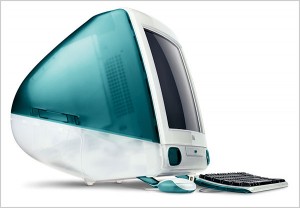
After three months of anticipation, the original iMac G3 goes on sale. The “Bondi Blue” iMac became well-known for its colorful case, which bucked the industry norm beige. However, it is also known for being the first commercially successful computer to eliminate the use of legacy ports and the floppy drive. Widely criticized at the time for not including the older technologies, by only featuring USB ports for peripheral connectivity, the iMac helped popularize the emerging standard, even on Windows PCs. And when was the last time anyone saw a beige PC?
I recall helping my uncle purchase one of the first iMacs at a CompUSA store on that first day. There were only 15 available and we were there early enough to grab one before they quickly sold out. Yes, I was totally jealous, but at least I got to help set it up 🙂
Dell Laptops Catch Fire!
Dell and Sony admit that flaws in Sony-manufactured batteries used in certain Dell laptops could result in the batteries overheating, catching fire, or exploding. This came after several widely publicized reports in the preceding months where Dell laptops did catch fire. They issue a recall of 4.1 million batteries, the largest safety recall in the history of the consumer electronics industry, still to this day. Even Samsung’s famous Galaxy Note 7 recall in 2016 only affected 2.5 million units. Dell’s reputation suffered for many years and to some, has never fully recovered from the incident.
The IBM PC Introduced
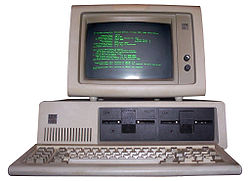
IBM introduces its first personal computer, the IBM PC Model 5150. IBM originally intended this model to be a stop-gap computer that would allow them to quickly tap into the emerging personal computer market while taking the time to develop a “real” PC. It was developed in under a year by a team of 12 with the goal of rapid release to market. Therefore, this team was allowed to work outside of the normal IBM development process and use whatever “off-the-shelf” components allowed for the quickest development. This overriding goal of developing something as quickly as possible had monumental unintended consequences for IBM and the computer industry as a whole that are still being felt to this day.
By compromising quality for rapidity, the design of the IBM PC forced software programmers to resort to inelegant methods of software development, hindering the reliability and compatibility of their software. This laid the groundwork for the reputation of the PC as error-prone and frustrating to use. The use of common components and the choice of Microsoft’s DOS as the PC’s operating system allowed other companies to quickly clone the IBM PC. They also allowed Microsoft to license their DOS to other companies, giving Microsoft control of the operating system market. Ultimately these choices lead to IBM’s loss of control of the platform. IBM never did really get a chance to create their “real” PC. And because IBM was the 800-pound gorilla of the business world at the time, the computer that was supposed to be a stop-gap became the overwhelming computing standard, crushing nearly every other emerging platform in the process.
Steve Jobs was quoted in a 1985 interview, “If … IBM wins, my personal feeling is that we are going to enter sort of a computer Dark Ages for about 20 years.” While IBM themselves didn’t win, the creation that they lost control of was the clear market winner for approximately the next 20 years. Many will argue that time was in fact a Dark Age for the home computer, but no one could have predicted that on this day in 1981.
The First E-mail From Space
Astronauts aboard the Space Shuttle Atlantis, mission STS-43, use an Apple Macintosh Portable computer to send what is considered the first e-mail from space. Using the AppleLink online service, Atlantis astronauts Shannon Lucid and James C. Adamson sent the following message:
Hello Earth! Greetings from the STS-43 Crew. This is the first AppleLink from space. Having a GREAT time, wish you were here,…send cryo and RCS! Hasta la vista, baby,…we’ll be back!
The AppleLink software on the Macintosh was specially configured to connect to NASA’s communication system which allowed the Shuttle to interface with Apple’s proprietary network from space. The Macintosh Portable itself only had very minor modifications to operate in space.

